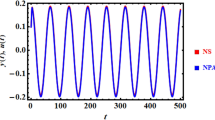Abstract
Numerical and experimental results concerning the control of chaos in the double-well Duffing system with one external force are presented in this paper. Lyapunov exponent is used as the identifier of chaos in the nonlinear system. As the expression of the potential function depends on the damping coefficient, it is found that the depth of the potential well increases with damping. Thus, this paper presents a physical insight into control damping (or coefficient of damping of a system) to quench, and also to prevent chaotic situations, which are considered disturbances and are harmful for operations. It is found that when the depth of the double-well potential increases, it becomes more difficult for the state to switch from one equilibrium to other, and thus, the chaos is suppressed. The new feedback control method based on damping coefficient and Lyapunov exponent is proposed. The experimental investigation using electronic components shows that the results obtained are similar to those observed from numerical investigation.












Similar content being viewed by others
References
P Bala, T S Gill and A S Bains India J. Phys. 91 1625 (2017)
S Ghosh and A Muley India. J. Phys. 92 121 (2018)
Y G Zheng and Z H Wang Nonlinear Dyn. 57 125 (2009)
H Simo and P Woafo Optik 127 1 (2016)
L T Abobda and P Woafo Eur. Phys. J. 223 2885 (2014)
B Hu, Z Liandong and Y Jingjing J. Mech. Sci. Technol. 30 5183 (2016)
Y S Kondji, G Fautso Kuiate and P Woafo Phys. Scr. 81 015010 (2010)
Z Meng, D Yang, H Zhou and B P Wang Struct. Multidisc. Optim. 57 91 (2018)
H Simo and P Woafo Int. J. Bifurcat. Chaos 22 1250003 (2012)
D O Tcheutchoua Fossi and P Woafo J. Vib. Acoust. 133 061018 (2011)
T Kingni Sifeu, S Jafari, H Simo and P Woafo Eur. Phys. J. Plus. 76 129 (2014)
L Dasheng and Y Hiroshi Nonlinear Dyn. 68 95 (2012)
H Wei, D Daweig, Z Yaqin and W Nian Optik 130 189 (2017)
L Chunbiao and J C Sprott Nonlinear Dyn. 73 1335 (2013)
M U Akmet and M O Fen Commun. Nonlinear Sci. Numer. Simul. 17 1929 (2012)
T Otto, C Grebogi, and J A Yorke Phys Rev Lett. 64 1196 (1990)
A L Sihem, S Bowong, F M Moukam Kakmeni, C Brahim and G Noureddine Commun. Nonlinear Sci. Numer. Simulat. 12 1504 (2007)
G P Jiang, W X Zheng Chaos Solitons Fractals 21 93 (2004)
R Chacon Eur. Phys. J. B 65 207 (2002)
R Ferma, Chaos 12 1027 (2002)
M T Yassen, Chaos Solitons Fractals 26 913 (2015)
A Alasty and H Slarieh Chaos Solitons Fractals 31 292 (2001)
W Ruiqi, D Jin and J Zhujun Chaos Solitons Fractals 27 249 (2006)
S Anjali, Vinod, Patidar, Purohit, K G Sud Commun. Nonlinear Sci. Numer. Simul. 17 2254 (2012)
Z Meng, G Li, B P Wang and P Hao Comput. Struct. 146 43 (2015)
Z Meng, G Li, D Yang and L Zhan Struct Multidisc. Optim. 55 12 (2017)
K Ivana and J B Michael, Nonlinear Oscillators and their Behaviour (New York: Wiley) (2011)
C A Kitio kwuimy, C Nataraj and G Litak, Chaos 21 043113 (2011)
L Longsuo and Y Hedan Chaos Solitons Fractals 44 498 (2011)
Acknowledgements
This work is supported by CV Raman international fellowship for African Researchers. The first author gratefully acknowledges the hospitality received at the control of vibration laboratory of the Department of Mechanical Engineering of the Indian Institute of Technology Delhi.
Author information
Authors and Affiliations
Corresponding author
Additional information
Publisher's Note
Springer Nature remains neutral with regard to jurisdictional claims in published maps and institutional affiliations.
Rights and permissions
About this article
Cite this article
Simo, H., Dutt, J.K. Effects of depth potential on the dynamics of Duffing system and chaos control: numerical and electronic implementation. Indian J Phys 94, 361–370 (2020). https://doi.org/10.1007/s12648-019-01451-5
Received:
Accepted:
Published:
Issue Date:
DOI: https://doi.org/10.1007/s12648-019-01451-5




